Magmatic Redox Evolution and Porphyry–Skarn Transition in Multiphase Cu-Mo-W-Au Systems of the Eocene Tavşanlı Belt, NW Türkiye
Abstract
1. Introduction
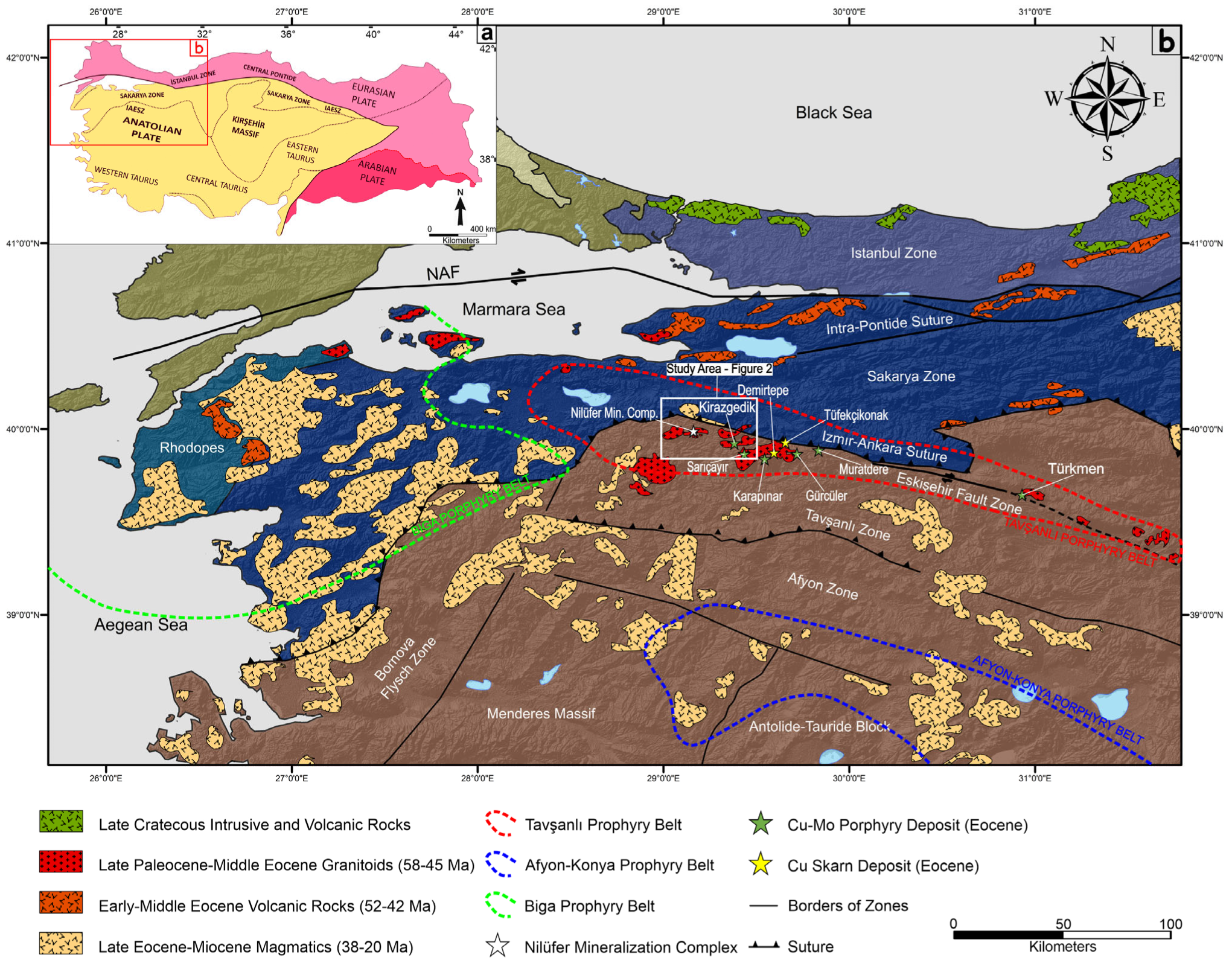
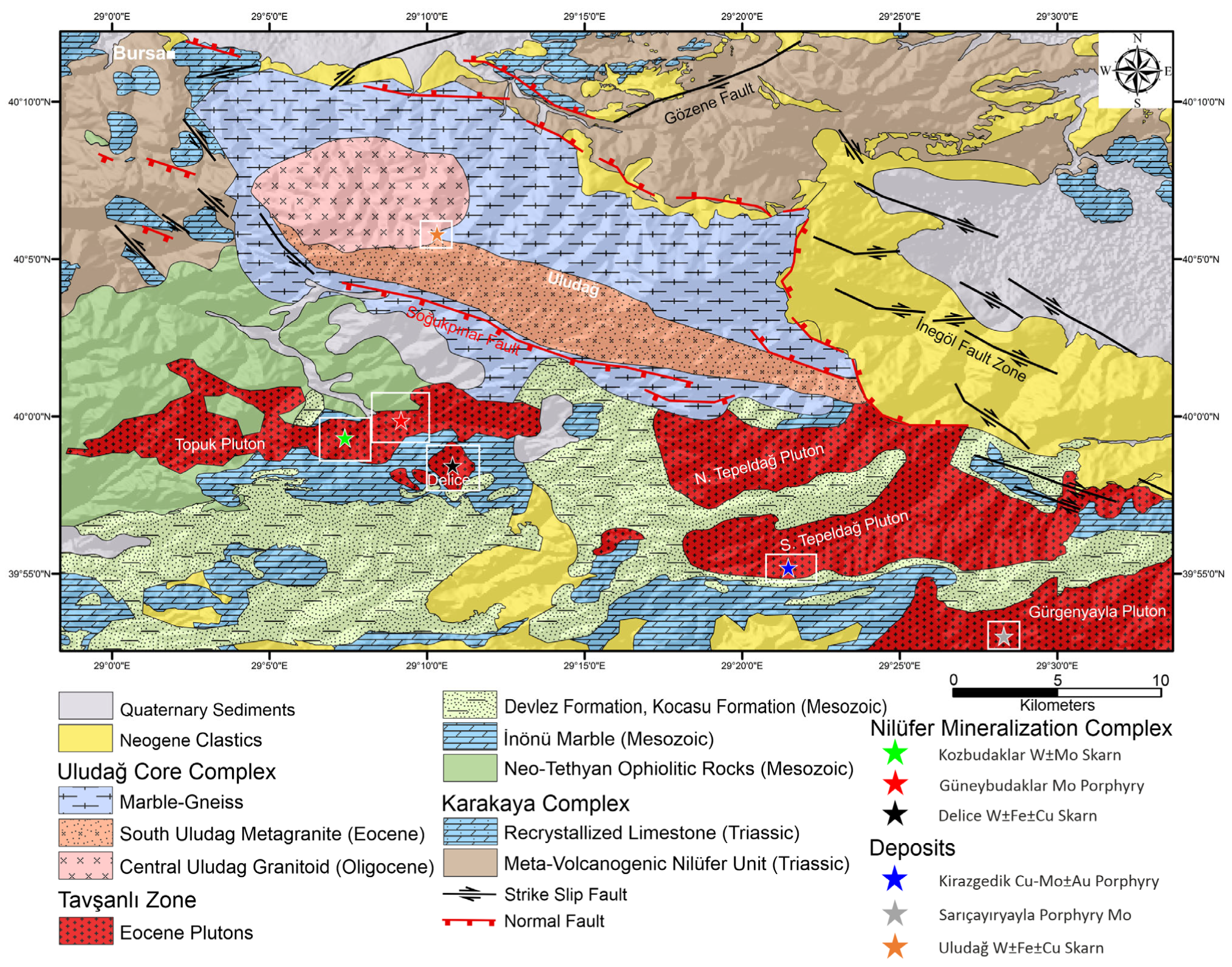
2. Geological Framework
3. Methodology
- Supplementary Table S1 details metadata for the 29 representative samples, including sample codes, lithological classifications, spatial information, and associated analytical datasets.
- Supplementary Table S2 presents whole-rock geochemical data (major oxides and trace elements, including REEs) for the 29 representative samples.
- Supplementary Table S3 reports ore element concentrations (Cu, Mo, W, Au, Ag, Bi, As, Te, Sb, Sn, Zn, Pb, Re) for the full set of 89 samples.
- Supplementary Tables S4 and S5 provide quantitative EPMA results for mica and amphibole, respectively, from selected representative samples.
- Supplementary Figures S1–S4 include representative back-scattered electron (BSE) images of amphibole and mica grains from across each study sector.
- Table 2 presents the Re-Os isotopic data and corresponding model age for a molybdenite-bearing sample from the Güneybudaklar mineralization.
3.1. Whole-Rock Geochemical Analysis (XRF & ICP-MS)
3.2. Electron Probe Micro-Analysis (EPMA)
3.3. Re-Os Geochronology
4. Results
4.1. Ore Geology
4.1.1. Kirazgedik Cu-Mo ± Au Porphyry Mineralization
4.1.2. Güneybudaklar Mo-W ± Au Porphyry-Skarn Mineralization
4.1.3. Kozbudaklar W ± Mo Skarn Mineralization
4.1.4. Delice W ± Fe ± Cu Skarn Mineralization
4.2. Whole-Rock Geochemistry
4.3. Re–Os Geochronology
4.4. Mineral Geochemistry
4.4.1. Mica Geochemistry
4.4.2. Amphibole Chemistry
5. Discussion
5.1. Tectono-Magmatic Framework and Temporal Constraints
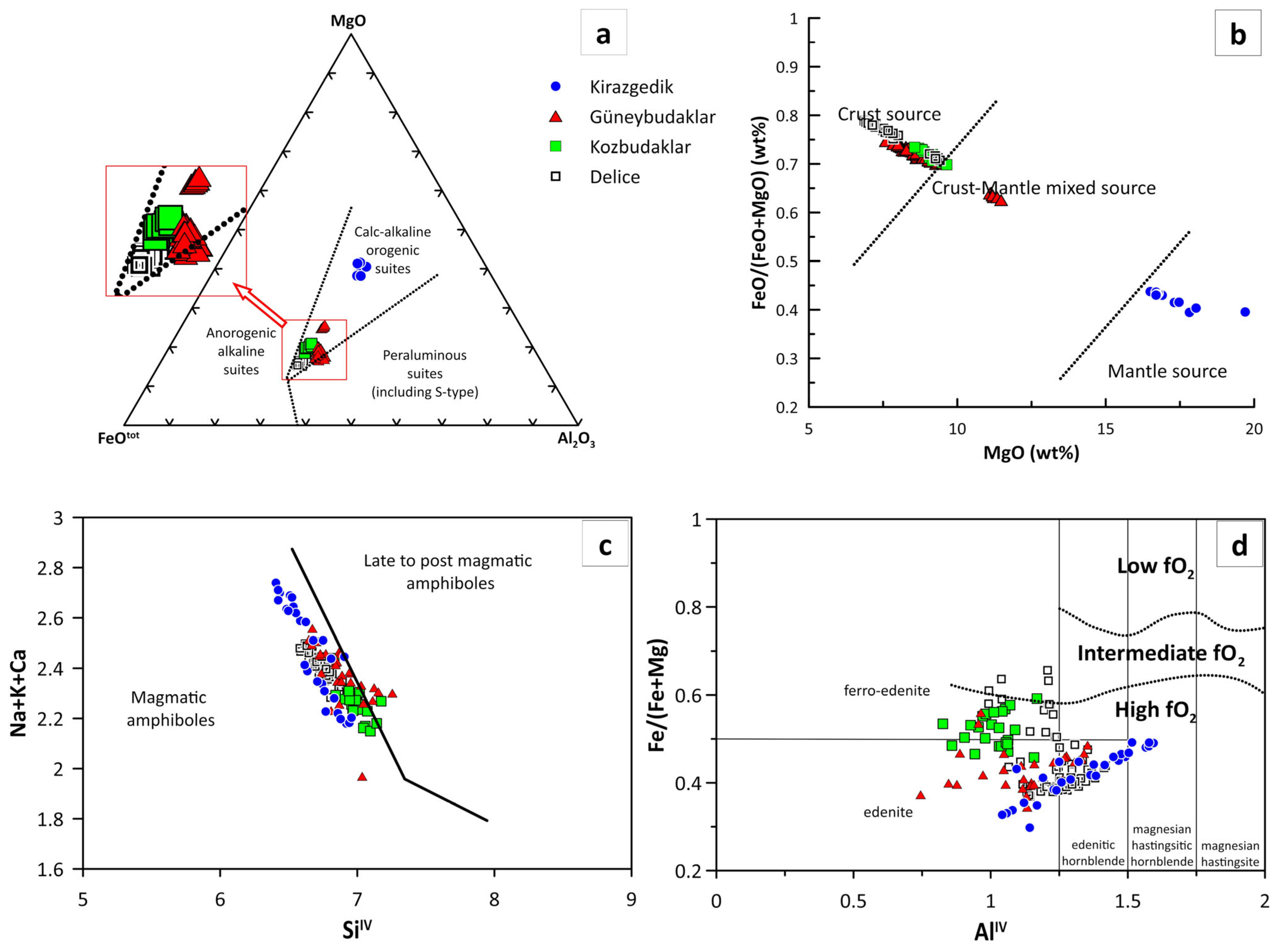
5.2. Mineralogical Discriminants as Vectors in Exploration
5.3. Thermo-Redox Evolution of Magmatic Pulses
5.4. Litho-Structural Controls and Metallogenic Model
6. Conclusions
Supplementary Materials
Author Contributions
Funding
Data Availability Statement
Acknowledgments
Conflicts of Interest
References
- Sillitoe, R.H. Porphyry copper systems. Econ. Geol. 2010, 105, 3–41. [Google Scholar] [CrossRef]
- Cooke, D.R.; Hollings, P.; Walshe, J.L. Giant porphyry deposits: Characteristics, distribution, and tectonic controls. Econ. Geol. 2005, 100, 801–818. [Google Scholar] [CrossRef]
- Kaya, M.; Kumral, M.; Yalçın, C.; Abdelnasser, A. Genesis and Evolution of the Yolindi Cu-Fe Skarn Deposit in the Biga Peninsula (NW Turkey): Insights from Genetic Relationships with Calc-Alkaline Magmatic Activity. Minerals 2023, 13, 1304. [Google Scholar] [CrossRef]
- Kaya, M.; Kumral, M.; Yalçın, C.; Abdelnasser, A. Sulfur and Carbon–Oxygen Isotopic Geochemistry and Fluid Inclusion Characteristics of the Yolindi Cu-Fe Skarn Mineralization, Biga Peninsula, NW Turkey: Implications for the Source and Evolution of Hydrothermal Fluids. Minerals 2023, 13, 1542. [Google Scholar] [CrossRef]
- Karaman, M.; Kumral, M.; Yildirim, D.K.; Doner, Z.; Afzal, P.; Abdelnasser, A. Delineation of the porphyry-skarn mineralized zones (NW Turkey) using concentration–volume fractal model. Geochemistry 2021, 4, 125802. [Google Scholar] [CrossRef]
- Abdelnasser, A.; Kumral, M.; Zoheir, B.; Yilmaz, H. Evolution of the Tepeoba porphyry-skarn Cu-Mo-Au deposit, NW Turkey: New mineralogical and geochemical findings. Ore Geol. Rev. 2022, 147, 104967. [Google Scholar] [CrossRef]
- Meinert, L.D.; Dipple, G.M.; Nicolescu, S.; Hedenquist, J.W.; Thompson, J.F.H.; Goldfarb, R.J.; Richards, J.P. World Skarn Deposits. In Economic Geology 100th Anniversary Volume; Society of Economic Geologists: Littleton, CO, USA, 2005; pp. 299–336. [Google Scholar]
- Richards, J. Metallogeny of the Neo-Tethys arc in central Iran. In Mineral Exploration and Sustainable Development; Millpress: Rotterdam, The Netherlands, 2003; pp. 1237–1239. [Google Scholar]
- Kocatürk, H. Genesis and Tectono-Metallogenic Evolution of Gold-Tungsten-Copper-Molybdenum (Au-W-Cu-Mo) Mineralizations Associated with Eocene Granitoids Around Uludağ (Bursa). Ph.D. Thesis, Istanbul Technical University, Istanbul, Turkiye, 2024. [Google Scholar]
- McFall, K.; Roberts, S.; McDonald, I.; Boyce, A.J.; Naden, J.; Teagle, D. Rhenium enrichment in the Muratdere Cu-Mo (Au-Re) porphyry deposit, Turkey: Evidence from stable isotope analyses (δ34S, δ18O, δD) and laser ablation-inductively coupled plasma-mass spectrometry analysis of sulfides. Econ. Geol. 2019, 114, 1443–1466. [Google Scholar] [CrossRef]
- Kuşcu, İ.; Tosdal, R.; Gençalioğlu-Kuşcu, G. Episodic Porphyry Cu (-Mo-Au) formation and associated magmatic evolution in Turkish Tethyan collage. Ore Geol. Rev. 2019, 107, 119–154. [Google Scholar] [CrossRef]
- Rabayrol, F.; Hart, C.J.; Friedman, R.M.; Spikings, R.A. Diachronous Magmatic and Cu-Au-Mo Metallogenic Responses to Slab Roll-Back Initiation from Northwest Anatolia to the Balkans, Western Tethyan Eocene Magmatic Belt. In Tectonomagmatic Influences on Metallogeny and Hydrothermal Ore Deposits: A Tribute to Jeremy P. Richards; Sholeh, A., Wang, R., Eds.; Society of Economic Geologists, Inc.: Littleton, CO, USA, 2021; Volume 1, pp. 17–28. [Google Scholar]
- Orhan, A. Evolution of the Mo-rich scheelite skarn mineralization at Kozbudaklar, Western Anatolia, Turkey: Evidence from mineral chemistry and fluid inclusions. Ore Geol. Rev. 2017, 80, 141–165. [Google Scholar] [CrossRef]
- Kocatürk, H.; Kumral, M.; Creaser, R.A.; DuFrane, S.A.; Ünlüer, A.T.; Sendir, H.; Döner, Z.; Kaya, M.; Özdamar, Ş.; Abdelnasser, A. Magma nature and tectono-magmatic context of the Eocene Uludağ granitoids (NW-Türkiye): Insights into the Cenozoic geodynamics of the Tethyan Orogenic Belt. Geochemistry 2024, 84, 126170. [Google Scholar] [CrossRef]
- Okay, A.I.; Tüysüz, O. Tethyan sutures of northern Turkey. Geol. Soc. Lond. Spec. Publ. 1999, 156, 475–515. [Google Scholar] [CrossRef]
- Kuşcu, İ.; Tosdal, R.M.; Gençalioğlu-Kuşcu, G. Porphyry-Cu Deposits of Turkey. In Mineral Resources of Turkey; Springer: Berlin/Heidelberg, Germany, 2019; pp. 337–425. [Google Scholar]
- Ridolfi, F.; Renzulli, A.; Puerini, M. Stability and chemical equilibrium of amphibole in calc-alkaline magmas: An overview, new thermobarometric formulations and application to subduction-related volcanoes. Contrib. Mineral. Petrol. 2010, 160, 45–66. [Google Scholar] [CrossRef]
- Ridolfi, F.; Renzulli, A. Calcic amphiboles in calc-alkaline and alkaline magmas: Thermobarometric and chemometric empirical equations valid up to 1,130 °C and 2.2 GPa. Contrib. Mineral. Petrol. 2012, 163, 877–895. [Google Scholar] [CrossRef]
- Li, X.; Zhang, C.; Almeev, R.R.; Zhang, X.-C.; Zhao, X.-F.; Wang, L.-X.; Koepke, J.; Holtz, F. Electron probe microanalysis of Fe2+/ΣFe ratios in calcic and sodic-calcic amphibole and biotite using the flank method. Chem. Geol. 2019, 509, 152–162. [Google Scholar] [CrossRef]
- Shafaii Moghadam, H.; Xiao, W.; Karsli, O.; Aydin, F.; He, Y.; Chiaradia, M.; Griffin, W.L. Copper endowment of the magmatic rocks from Eastern Sakarya Zone (Türkiye): Insights from zircon and apatite geochemical evolution. Contrib. Mineral. Petrol. 2025, 180, 38. [Google Scholar] [CrossRef]
- Duan, X.-X.; Ju, Y.-F.; Chen, B.; Wang, Z.-Q. Garnet geochemistry of reduced Skarn system: Implications for fluid evolution and Skarn formation of the Zhuxiling W (Mo) deposit, China. Minerals 2020, 10, 1024. [Google Scholar] [CrossRef]
- Carter, L.C.; Tapster, S.R.; Williamson, B.J.; Buret, Y.; Selby, D.; Rollinson, G.K.; Millar, I.; Parvaz, D.B. A rapid change in magma plumbing taps porphyry copper deposit-forming magmas. Sci. Rep. 2022, 12, 17272. [Google Scholar] [CrossRef]
- Plunder, A.; Agard, P.; Chopin, C.; Okay, A.I. Geodynamics of the Tavşanlı zone, western Turkey: Insights into subduction/obduction processes. Tectonophysics 2013, 608, 884–903. [Google Scholar] [CrossRef]
- Okay, A.I.; Harris, N.B.; Kelley, S.P. Exhumation of blueschists along a Tethyan suture in northwest Turkey. Tectonophysics 1998, 285, 275–299. [Google Scholar] [CrossRef]
- Plunder, A.; Agard, P.; Chopin, C.; Pourteau, A.; Okay, A.I. Accretion, underplating and exhumation along a subduction interface: From subduction initiation to continental subduction (Tavşanlı zone, W. Turkey). Lithos 2015, 226, 233–254. [Google Scholar] [CrossRef]
- Okay, A.I. Tavşanli zone: The northern subducted margin of the Anatolide-Tauride block. Bull. Miner. Res. Explor. 2011, 142, 191–221. [Google Scholar]
- Okay, A.I.; Satir, M. Geochronology of Eocene plutonism and metamorphism in northwest. Geodin. Acta 2006, 19, 251–266. [Google Scholar] [CrossRef]
- Sarifakioğlu, E.; Özen, H.; Winchester, J.A. Whole rock and mineral chemistry of ultramafic-mafic cumulates from the Orhaneli (Bursa) ophiolite, NW Anatolia. Turk. J. Earth Sci. 2009, 18, 55–83. [Google Scholar] [CrossRef]
- Altunkaynak, Ş.; Sunal, G.; Aldanmaz, E.; Genç, C.Ş.; Dilek, Y.; Furnes, H.; Foland, K.A.; Yang, J.; Yıldız, M. Eocene Granitic Magmatism in NW Anatolia (Turkey) revisited: New implications from comparative zircon SHRIMP U–Pb and 40Ar–39Ar geochronology and isotope geochemistry on magma genesis and emplacement. Lithos 2012, 155, 289–309. [Google Scholar] [CrossRef]
- Selby, D.; Creaser, R.A. Macroscale NTIMS and microscale LA-MC-ICP-MS Re-Os isotopic analysis of molybdenite: Testing spatial restrictions for reliable Re-Os age determinations, and implications for the decoupling of Re and Os within molybdenite. Geochim. Cosmochim. Acta 2004, 68, 3897–3908. [Google Scholar] [CrossRef]
- Markey, R.; Stein, H.J.; Hannah, J.L.; Zimmerman, A.; Selby, D.; Creaser, R.A. Standardizing Re–Os geochronology: A new molybdenite reference material (Henderson, USA) and the stoichiometry of Os salts. Chem. Geol. 2007, 244, 74–87. [Google Scholar] [CrossRef]
- Smoliar, M.I.; Walker, R.J.; Morgan, J.W. Re-Os ages of group IIA, IIIA, IVA, and IVB iron meteorites. Science 1996, 271, 1099–1102. [Google Scholar] [CrossRef]
- Orhan, A.; Demirbilek, M.; Mutlu, H. Mineral and whole-rock geochemistry of the Topuk Granitoid (Bursa, Western Anatolia, Turkey). In Proceedings of the EGU General Assembly Conference Abstracts, Vienna, Austria, 27 April–2 May 2014; p. 5103. [Google Scholar]
- Orhan, A.; Mutlu, H. Geochemical characteristics and rare-earth element distributions of Kozbudaklar W-Skarn Deposit (Bursa, Western Anatolia). Bull. Miner. Res. Explor. 2017, 155, 115–130. [Google Scholar] [CrossRef]
- Kumral, M.; Abdelnasser, A.; Budakoglu, M. Geochemistry of Hydrothermal Alteration Associated with Cenozoic Intrusion-Hosted Cu-Pb-Zn Mineralization at Tavşanlı Area, Kütahya, NW Turkey. Minerals 2016, 6, 13. [Google Scholar] [CrossRef]
- Doner, Z.; Unluer, A.T.; Özdamar, Ş.; Sarıkaya, O.; Roden, M.F.; Kaya, M.; Kocaturk, H.; Kumral, M.; Esenli, F. The origin of alkali granites and Th-U ± REE enrichments in Kestanbol Magmatic complex (NW Anatolia) revisited: Evidences from bulk-rock geochemistry and isotopic data, zircon UPb, biotite Ar/Ar and apatite (UTh)/He geochronology. Lithos 2024, 484–485, 107751. [Google Scholar] [CrossRef]
- Janoušek, V.; Farrow, C.M.; Erban, V. Interpretation of whole-rock geochemical data in igneous geochemistry: Introducing Geochemical Data Toolkit (GCDkit). J. Petrol. 2006, 47, 1255–1259. [Google Scholar] [CrossRef]
- El Bouseily, A.; El Sokkary, A. The relation between Rb, Ba and Sr in granitic rocks. Chem. Geol. 1975, 16, 207–219. [Google Scholar] [CrossRef]
- Foley, S.F.; Venturelli, G.; Green, D.H.; Toscani, L. The ultrapotassic rocks: Characteristics, classification, and constraints for petrogenetic models. Earth-Sci. Rev. 1987, 24, 81–134. [Google Scholar] [CrossRef]
- Rollinson, H. Using Geochemical Data: Evolution, Presentation, Interpretation; Longman Scientific and Technical: London, UK, 1993; p. 352. [Google Scholar]
- Le Maitre, R.W. Igneous Rocks: A Classification and Glossary of Terms; Cambridge University Press: Cambridge, UK, 2002; p. 237. [Google Scholar]
- Davidson, J.; Turner, S.; Handley, H.; Macpherson, C.; Dosseto, A. Amphibole “sponge” in arc crust? Geology 2007, 35, 787–790. [Google Scholar] [CrossRef]
- McKenzie, D.; O’nions, R. Partial Melt Distributions from Inversion of Rare Earth Element Concentrations. J. Petrol. 1991, 32, 1021–1091. [Google Scholar] [CrossRef]
- Pearce, J.A.; Harris, N.B.; Tindle, A.G. Trace element discrimination diagrams for the tectonic interpretation of granitic rocks. J. Petrol. 1984, 25, 956–983. [Google Scholar] [CrossRef]
- Bonin, B. Do coeval mafic and felsic magmas in post-collisional to within-plate regimes necessarily imply two contrasting, mantle and crustal, sources? A review. Lithos 2004, 78, 1–24. [Google Scholar] [CrossRef]
- Debon, F.; Le Fort, P. A chemical–mineralogical classification of common plutonic rocks and associations. Earth Environ. Sci. Trans. R. Soc. Edinb. 1983, 73, 135–149. [Google Scholar] [CrossRef]
- Miyashiro, A. Volcanic rock series in island arcs and active continental margins. Am. J. Sci. 1974, 274, 321–355. [Google Scholar] [CrossRef]
- Peccerillo, A.; Taylor, S. Geochemistry of Eocene calc-alkaline volcanic rocks from the Kastamonu area, northern Turkey. Contrib. Mineral. Petrol. 1976, 58, 63–81. [Google Scholar] [CrossRef]
- Laurent, A.; Janousek, V.; Magna, T.; Schulmann, K.; Mikova, J. Petrogenesis and geochronology of a post-orogenic calc-alkaline magmatic association: The Zulova Pluton, Bohemian Massif. J. Geosci. 2014, 59, 415–440. [Google Scholar] [CrossRef]
- Pearce, J. Sources and settings of granitic rocks. Epis. J. Int. Geosci. 1996, 19, 120–125. [Google Scholar] [CrossRef]
- Gill, J.B. Orogenic Andesites and Plate Tectonics; Springer Science & Business Media: Berlin/Heidelberg, Germany, 1981; Volume 16, p. 390. [Google Scholar]
- Pearce, J.A. Trace element characteristics of lavas from destructive plate boundaries. In Orogenic Andesites and Related Rocks; Wiley: Hoboken, NJ, USA, 1982; pp. 528–548. [Google Scholar]
- Boynton, W.V. Geochemistry of Rare Earth Elements: Meteorite Studies. In Rare Earth Element Geochemistry; Henderson, P., Ed.; Elsevier: New York, NY, USA, 1984; pp. 63–114. [Google Scholar] [CrossRef]
- Sun, S.-S.; McDonough, W. Chemical and isotopic systematics of oceanic basalts: Implications for mantle composition and processes. Geol. Soc. Lond. Spec. Publ. 1989, 42, 313–345. [Google Scholar] [CrossRef]
- Tischendorf, G.; Gottesmann, B.; Förster, H.-J.; Trumbull, R.B. On Li-bearing micas: Estimating Li from electron microprobe analyses and an improved diagram for graphical representation. Mineral. Mag. 1997, 61, 809–834. [Google Scholar] [CrossRef]
- Nachit, H.; Ibhi, A.; Ohoud, M.B. Discrimination between primary magmatic biotites, reequilibrated biotites and neoformed biotites. Comptes Rendus Géosci. 2005, 337, 1415–1420. [Google Scholar] [CrossRef]
- Leake, B.E.; Woolley, A.R.; Arps, C.E.; Birch, W.D.; Gilbert, M.C.; Grice, J.D.; Hawthorne, F.C.; Kato, A.; Kisch, H.J.; Krivovichev, V.G. Nomenclature of amphiboles; report of the subcommittee on amphiboles of the International Mineralogical Association, Commission on New Minerals and Mineral Names. Can. Mineral. 1997, 35, 219–246. [Google Scholar]
- Pourteau, A.; Oberhänsli, R.; Candan, O.; Barrier, E.; Vrielynck, B. Neotethyan closure history of western Anatolia: A geodynamic discussion. Int. J. Earth Sci. 2016, 105, 203–224. [Google Scholar] [CrossRef]
- Tirel, C.; Brun, J.-P.; Burov, E.; Wortel, M.; Lebedev, S. A plate tectonics oddity: Caterpillar-walk exhumation of subducted continental crust. Geology 2013, 41, 555–558. [Google Scholar] [CrossRef]
- Müller, D.; Groves, D.I. Potassic Igneous Rocks and Associated Gold-Copper Mineralization, 4th ed.; Springer: Cham, Switzerland, 2016. [Google Scholar]
- Müller, D.; Rock, N.; Groves, D. Geochemical Discrimination between Shoshonitic and Potassic Volcanic Rocks in Different Tectonic Settings: A Pilot Study. Mineral. Petrol. 1992, 46, 259–289. [Google Scholar] [CrossRef]
- Park, J.-W.; Campbell, I.H.; Chiaradia, M.; Hao, H.; Lee, C.-T. Crustal magmatic controls on the formation of porphyry copper deposits. Nat. Rev. Earth Environ. 2021, 2, 542–557. [Google Scholar] [CrossRef]
- Putirka, K. Special Collection: Rates and Depths of Magma Ascent on Earth: Amphibole thermometers and barometers for igneous systems and some implications for eruption mechanisms of felsic magmas at arc volcanoes. Am. Mineral. 2016, 101, 841–858. [Google Scholar] [CrossRef]
- Luo, C.-H.; Wang, R.; Nebel, O.; Li, Q.-W. Amphibole fractionation as a key driver for oxidation of magmas in convergent margins. Earth Planet. Sci. Lett. 2024, 641, 118851. [Google Scholar] [CrossRef]
- Frost, B.R.; Barnes, C.G.; Collins, W.J.; Arculus, R.J.; Ellis, D.J.; Frost, C.D. A geochemical classification for granitic rocks. J. Petrol. 2001, 42, 2033–2048. [Google Scholar] [CrossRef]
- Moyen, J.-F. High Sr/Y and La/Yb ratios: The meaning of the “adakitic signature”. Lithos 2009, 112, 556–574. [Google Scholar] [CrossRef]
- Heinrich, C.A.; Candela, P.A. Fluids and ore formation in the Earth’s crust. In Treatise on Geochemistry, 2nd ed.; Elsevier: Amsterdam, The Netherlands, 2014; Volume 13, pp. 1–28. [Google Scholar]
- Codeço, M.S.; Weis, P.; Andersen, C. Numerical modeling of structurally controlled ore formation in magmatic-hydrothermal systems. Geochem. Geophys. Geosystems 2022, 23, e2021GC010302. [Google Scholar] [CrossRef]
- Blanquat, M.D.S.; Tikoff, B.; Teyssier, C.; Vigneresse, J.L. Transpressional kinematics and magmatic arcs. Geol. Soc. Lond. Spec. Publ. 1998, 135, 327–340. [Google Scholar] [CrossRef]
- Murphy, J.B. Igneous rock associations 7. Arc magmatism I: Relationship between subduction and magma genesis. Geosci. Can. 2006, 33, 145–168. [Google Scholar]
- Oriolo, S.; Gómez, A.L.R.; Maffini, M.N.; Oyhantçabal, P.; Demarco, M.M.; Vargas Perucca, M.S.; Bastías Torres, M.V.; Rubinstein, N.A. Transtension, brittle-ductile shear zones and hydrothermal ore deposits: Towards quantitative structural and kinematic models. J. Struct. Geol. 2024, 185, 105173. [Google Scholar] [CrossRef]
- Contreras-Reyes, E.; Díaz, D.; Bello-González, J.P.; Slezak, K.; Potin, B.; Comte, D.; Maksymowicz, A.; Ruiz, J.A.; Osses, A.; Ruiz, S. Subduction zone fluids and arc magmas conducted by lithospheric deformed regions beneath the central Andes. Sci. Rep. 2021, 11, 23078. [Google Scholar] [CrossRef]
- Abdel-rahman, A.-F.M. Nature of Biotites from Alkaline, Calc-alkaline, and Peraluminous Magmas. J. Petrol. 1994, 35, 525–541. [Google Scholar] [CrossRef]
- Zhou, Z. The origin of intrusive mass in Fengshandong, Hubei province. Acta Petrol. Sin. 1986, 2, 59–70. [Google Scholar]
- Czamanske, G.K.; Wones, D.R. Oxidation during magmatic differentiation, Finnmarka complex, Oslo area, Norway: Part 2, the mafic silicates1. J. Petrol. 1973, 14, 349–380. [Google Scholar] [CrossRef]
- Anderson, J.L.; Smith, D.R. The effects of temperature and fO2 on the Al-in-hornblende barometer. Am. Mineral. 1995, 80, 549–559. [Google Scholar] [CrossRef]
- Audétat, A.; Günther, D.; Heinrich, C.A. Causes for large-scale metal zonation around mineralized plutons: Fluid inclusion LA-ICP-MS evidence from the Mole Granite, Australia. Econ. Geol. 2000, 95, 1563–1581. [Google Scholar] [CrossRef]
- Loucks, R.R. Distinctive composition of copper-ore-forming arcmagmas. Aust. J. Earth Sci. 2014, 61, 5–16. [Google Scholar] [CrossRef]
- Icenhower, J.P.; London, D. Partitioning of fluorine and chlorine between biotite and granitic melt: Experimental calibration at 200 MPa H2O. Contrib. Mineral. Petrol. 1997, 127, 17–29. [Google Scholar] [CrossRef]
- Reed, M.H.; Palandri, J. Sulfide mineral precipitation from hydrothermal fluids. Rev. Mineral. Geochem. 2006, 61, 609–631. [Google Scholar] [CrossRef]
- Chelle-Michou, C.; Rottier, B.; Caricchi, L.; Simpson, G. Tempo of magma degassing and the genesis of porphyry copper deposits. Sci. Rep. 2017, 7, 40566. [Google Scholar] [CrossRef] [PubMed]
- Chelle-Michou, C.; Chiaradia, M. Amphibole and apatite insights into the evolution and mass balance of Cl and S in magmas associated with porphyry copper deposits. Contrib. Mineral. Petrol. 2017, 172, 105. [Google Scholar] [CrossRef]
- Cai, W.-y.; Wang, K.-y.; Li, J.; Fu, L.-j.; Li, S.-d.; Yang, H.; Konare, Y. Genesis of the Bagenheigeqier Pb–Zn skarn deposit in Inner Mongolia, NE China: Constraints from fluid inclusions, isotope systematics and geochronology. Geol. Mag. 2021, 158, 271–294. [Google Scholar] [CrossRef]
- Zhao, X.; Yang, Z.; Zheng, Y.; Liu, Y.; Tian, S.; Fu, Q. Geology and genesis of the post-collisional porphyry–skarn deposit at Bangpu, Tibet. Ore Geol. Rev. 2015, 70, 486–509. [Google Scholar] [CrossRef]
- Chiaradia, M. Adakite-like magmas from fractional crystallization and melting-assimilation of mafic lower crust (Eocene Macuchi arc, Western Cordillera, Ecuador). Chem. Geol. 2009, 265, 468–487. [Google Scholar] [CrossRef]
- Song, G.; Cook, N.J.; Li, G.; Qin, K.; Ciobanu, C.L.; Yang, Y.; Xu, Y. Scheelite geochemistry in porphyry-skarn W-Mo systems: A case study from the Gaojiabang Deposit, East China. Ore Geol. Rev. 2019, 113, 103084. [Google Scholar] [CrossRef]
- Li, W.; Cheng, Y.; Yang, Z. Geo-fO2: Integrated software for analysis of magmatic oxygen fugacity. Geochem. Geophys. Geosyst. 2019, 20, 2542–2555. [Google Scholar] [CrossRef]
- Wilkinson, J.J. Triggers for the formation of porphyry ore deposits in magmatic arcs. Nat. Geosci. 2013, 6, 917–925. [Google Scholar] [CrossRef]
- Dilles, J.; Barton, M.; Johnson, D.; Proffett, J.; Einaudi, M. Part I. Contrasting Styles of Intrusion-Associated Hydrothermal Systems; Guidebook Series; Society of Economic Geologists, Inc.: Littleton, CO, USA, 2000; Volume 32, pp. 1–162. [Google Scholar]
- Krawczynski, M.J.; Grove, T.L.; Behrens, H. Amphibole stability in primitive arc magmas: Effects of temperature, H2O content, and oxygen fugacity. Contrib. Mineral. Petrol. 2012, 164, 317–339. [Google Scholar] [CrossRef]
- Richards, J.P. Magmatic to hydrothermal metal fluxes in convergent and collided margins. Ore Geol. Rev. 2011, 40, 1–26. [Google Scholar] [CrossRef]
- Keppler, H. Fluids and trace element transport in subduction zones. Am. Mineral. 2017, 102, 5–20. [Google Scholar] [CrossRef]
- Candela, P.A.; Piccoli, P.M. Magmatic processes in the development of porphyry-type ore systems. In One Hundredth Anniversary Volume; Hedenquist, J.W., Thompson, J.F.H., Goldfarb, R.J., Richards, J.P., Eds.; Society of Economic Geologists: Washington, DC, USA, 2005. [Google Scholar]
- Heinrich, C.A. Fluid-fluid interactions in magmatic-hydrothermal ore formation. Rev. Mineral. Geochem. 2007, 65, 363–387. [Google Scholar] [CrossRef]
- Dilles, J.H.; Kent, A.J.R.; Wooden, J.L.; Tosdal, R.M.; Koleszar, A.; Lee, R.G.; Farmer, L.P. Zircon compositional evidence for sulfur-degassing from ore-forming arc magmas*. Econ. Geol. 2015, 110, 241–251. [Google Scholar] [CrossRef]
- Ishihara, S. The granitoid series and mineralization. In Seventy-Fifth Anniversary Volume: 1905–1980; Skinner, B.J., Ed.; Economic Geology Publishing Company: McLean, VA, USA, 1981. [Google Scholar]
- Ballard, J.R.; Palin, J.M.; Campbell, I.H. Relative oxidation states of magmas inferred from Ce(IV)/Ce(III) in zircon: Application to porphyry copper deposits of northern Chile. Contrib. Mineral. Petrol. 2002, 144, 347–364. [Google Scholar] [CrossRef]
- Candela, P.; Piccoli, P. Model ore-metal partitioning from melts into vapor and vapor/brine mixtures. In Magma, Fluids and Ore Deposits; Thompson, J., Ed.; Mineralogical Association of Canada Short Course: Québec, QC, Canada, 1995; Volume 23, pp. 101–127. [Google Scholar]
- Huang, P.-C.; Yu, J.; Yao, J.-M.; Qi, N.; Qiu, Z.-W.; Chen, Y.-J. Case study of the large-scale Mo-W mineralization in Eastern Qinling, China: Geology and genesis of the Yechangping porphyry-skarn system. Ore Geol. Rev. 2024, 165, 105867. [Google Scholar] [CrossRef]
- Zhan, Q.; Gao, X.-Y.; Meng, L.; Zhao, T.-P. Ore genesis and fluid evolution of the Sandaozhuang supergiant W-Mo skarn deposit, southern margin of the North China Craton: Insights from scheelite, garnet and clinopyroxene geochemistry. Ore Geol. Rev. 2021, 139, 104551. [Google Scholar] [CrossRef]
- Ouyang, Y.; Hou, Z.; He, X.; Pan, X.; Wei, J.; Zeng, R.; Chen, Q. Geochronological, geochemical and isotopic constraints on the genesis of Cu mineralization in the giant Zhuxi W–Cu deposit, South China. Ore Geol. Rev. 2025, 184, 106767. [Google Scholar] [CrossRef]
- Wu, S.; Sun, W.; Wang, X. A new model for porphyry W mineralization in a world-class tungsten metallogenic belt. Ore Geol. Rev. 2019, 107, 501–512. [Google Scholar] [CrossRef]
- Sillitoe, R. Characteristics and controls of the largest porphyry copper-gold and epithermal gold deposits in the circum-Pacific region. Aust. J. Earth Sci. 1997, 44, 373–388. [Google Scholar] [CrossRef]
- Soloviev, S.G.; Kryazhev, S.G.; Shapovalenko, V.N.; Dvurechenskaya, S.S.; Semenova, D.V.; Kalinin, Y.A.; Voskresensky, K.I.; Sidorova, N.V. The Glafirinskoe and related skarn Cu-Au-W-Mo deposits in the Northern Altai, SW Siberia, Russia: Geology, igneous geochemistry, zircon U-Pb geochronology, mineralization, and fluid inclusion characteristics. Ore Geol. Rev. 2021, 138, 104382. [Google Scholar] [CrossRef]
- Soloviev, S.G. Late Palaeozoic high-K calc-alkaline to shoshonitic series magmatism and related W (–Mo–Cu–Au) metallogeny of the Kyrgyz Tien Shan, Central Asia. Geol. Soc. Lond. Spec. Publ. 2024, 551, 231–258. [Google Scholar] [CrossRef]
- Kumral, M.; Kabiru, M.; Aydogan, M.S.; Kocaturk, H.; Unluer, A.T. The Soma polymetallic hydrothermal Pb–Zn-Cu(± Mo ± Ag ± Au) mineralizations in the south of Biga Peninsula, NW Turkey: Constraints from mineralogy, geochemistry, and fluid inclusion data. Arab. J. Geosci. 2022, 15, 1172. [Google Scholar] [CrossRef]
- Kocaturk, H.; Sendir, H.; Kumral, M.; Unluer, A.; Budakoglu, M. Isotopic Features and Fluid Charecterization of Ore Forming Process Gurgenyayla and Bogazova Plutons (Kütahya/Bursa/Bilecik-Turkey). Magmat. Earth Relat. Strateg. Met. Depos. 2018, 138–141. [Google Scholar]
- Mao, J.; Pirajno, F.; Cook, N. Mesozoic metallogeny in East China and corresponding geodynamic settings—An introduction to the special issue. Ore Geol. Rev. 2011, 43, 1–7. [Google Scholar] [CrossRef]
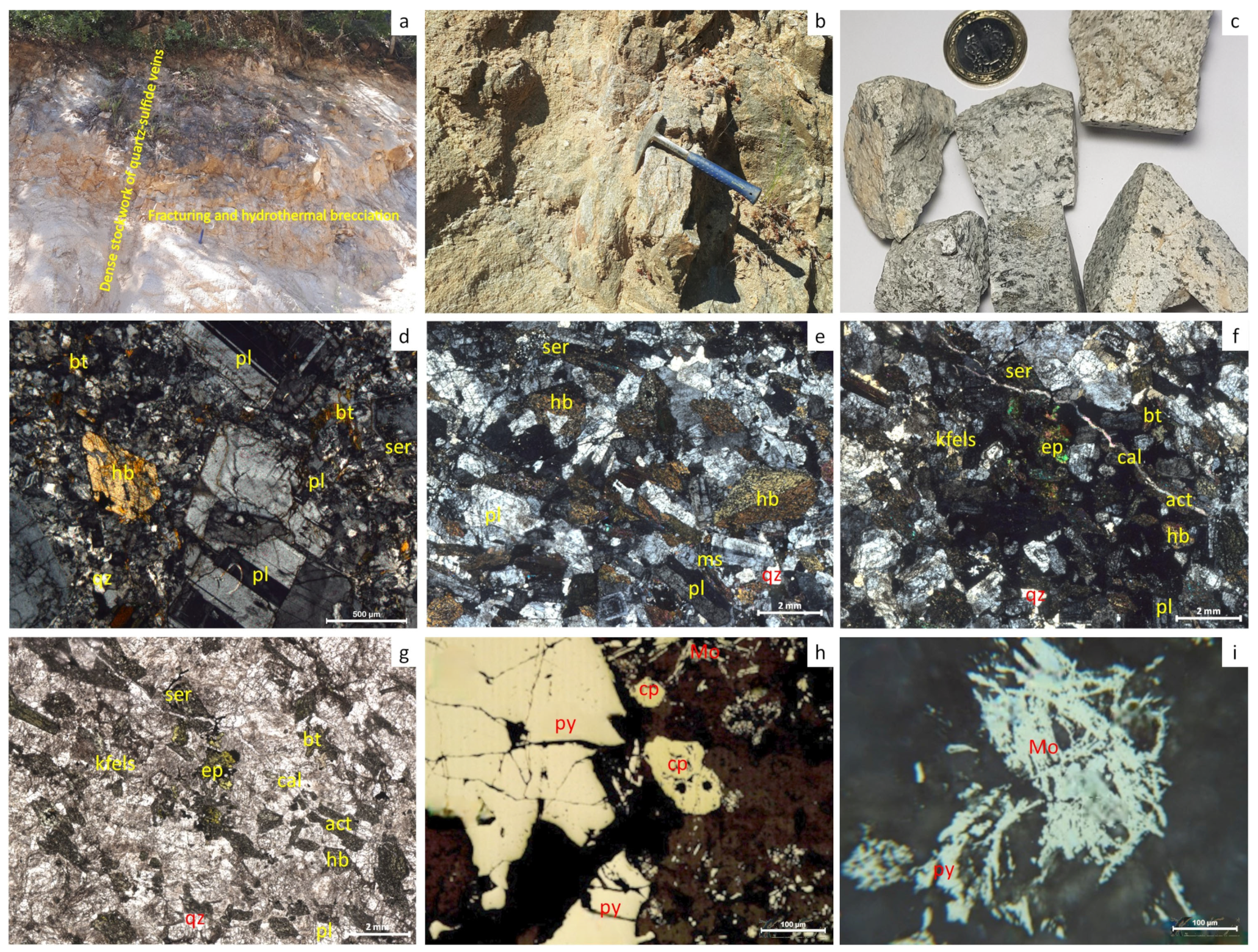
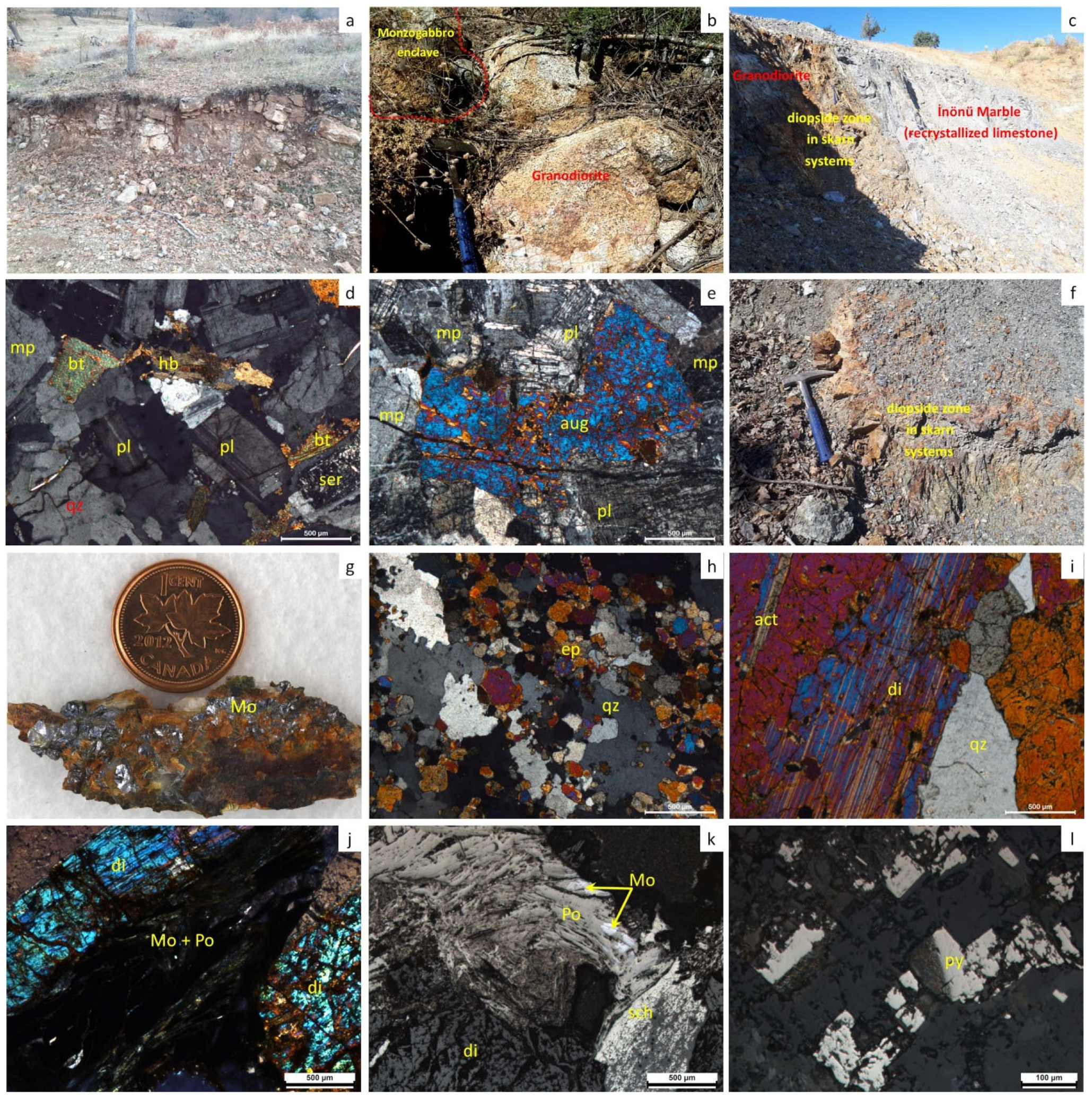
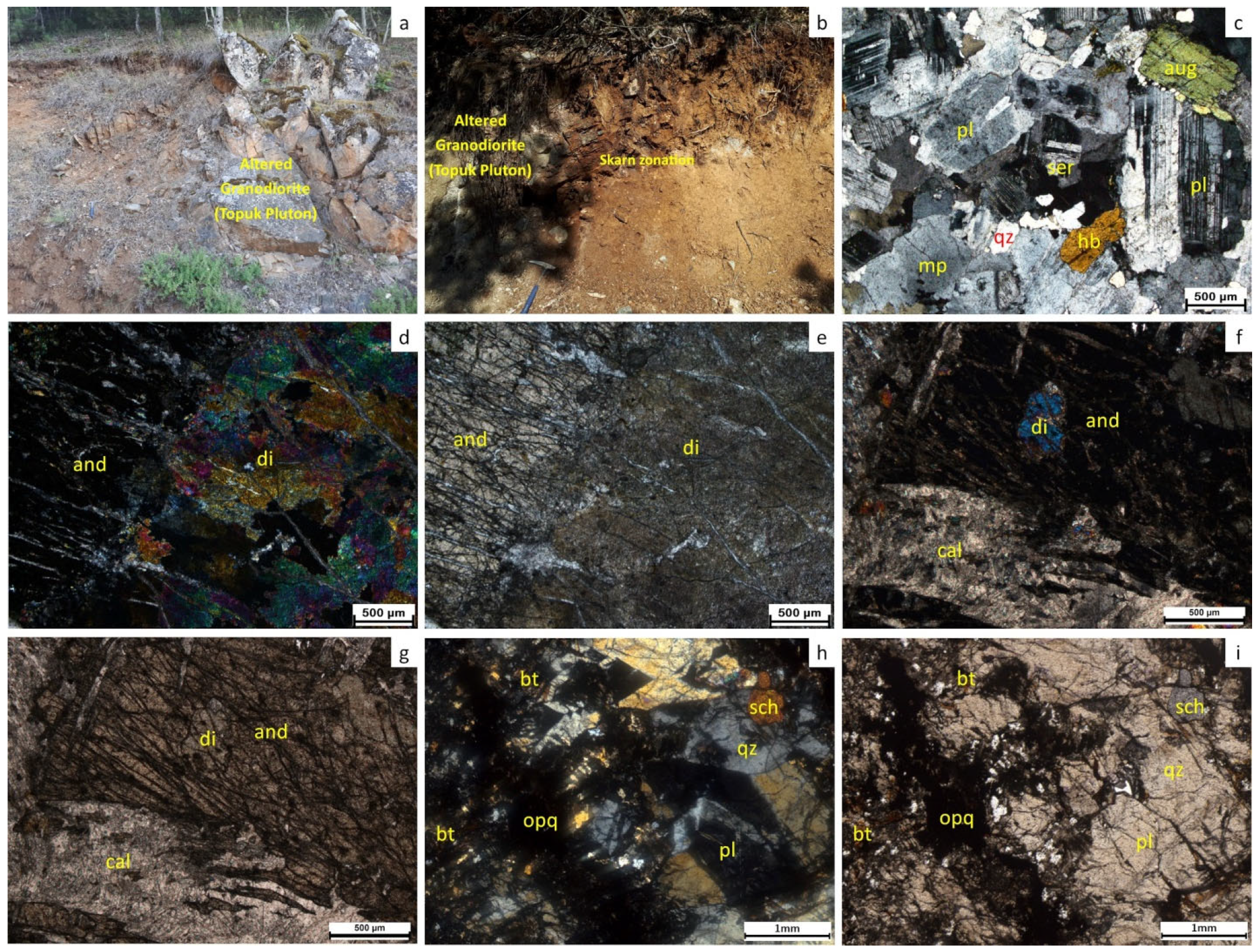
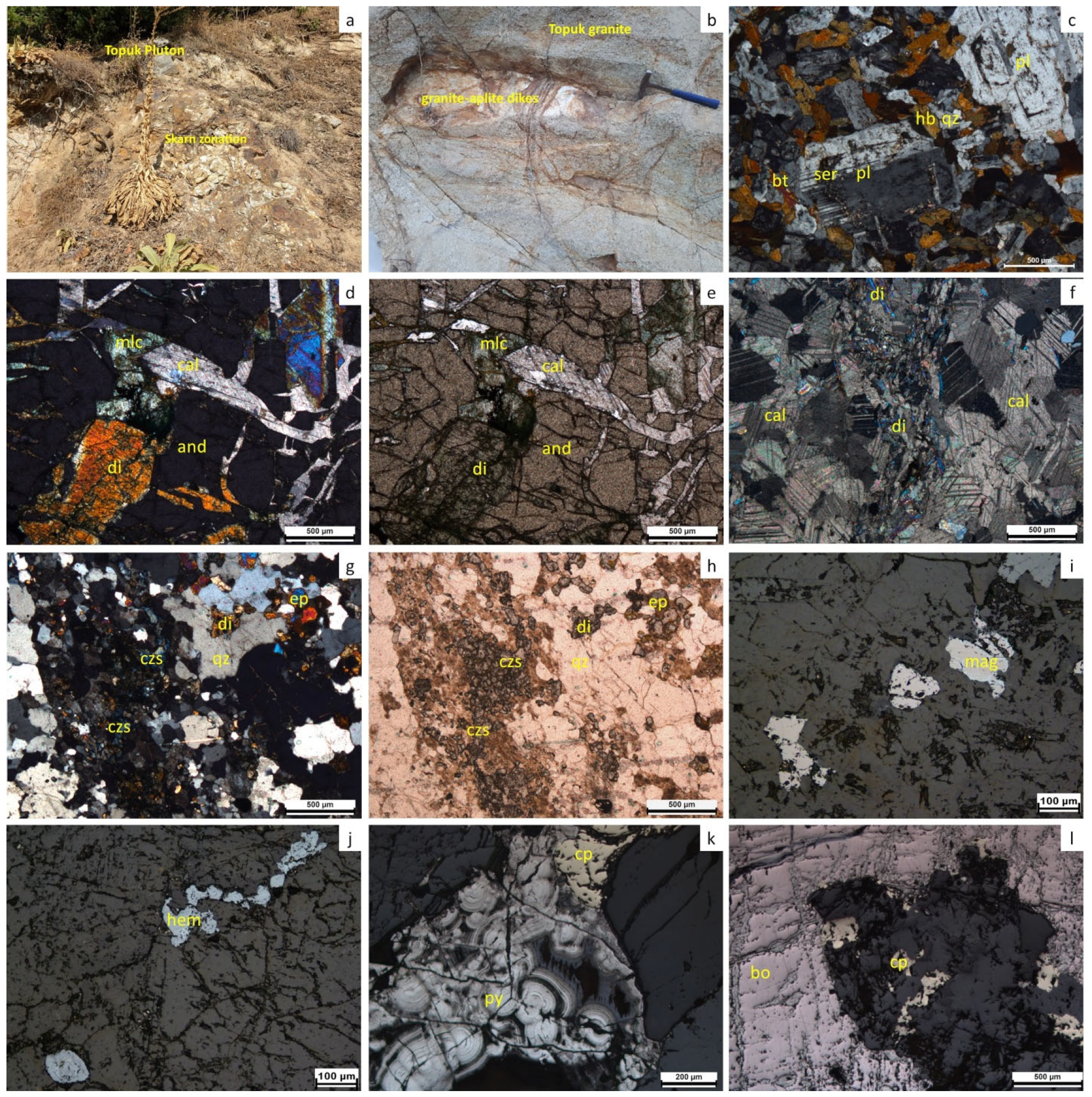
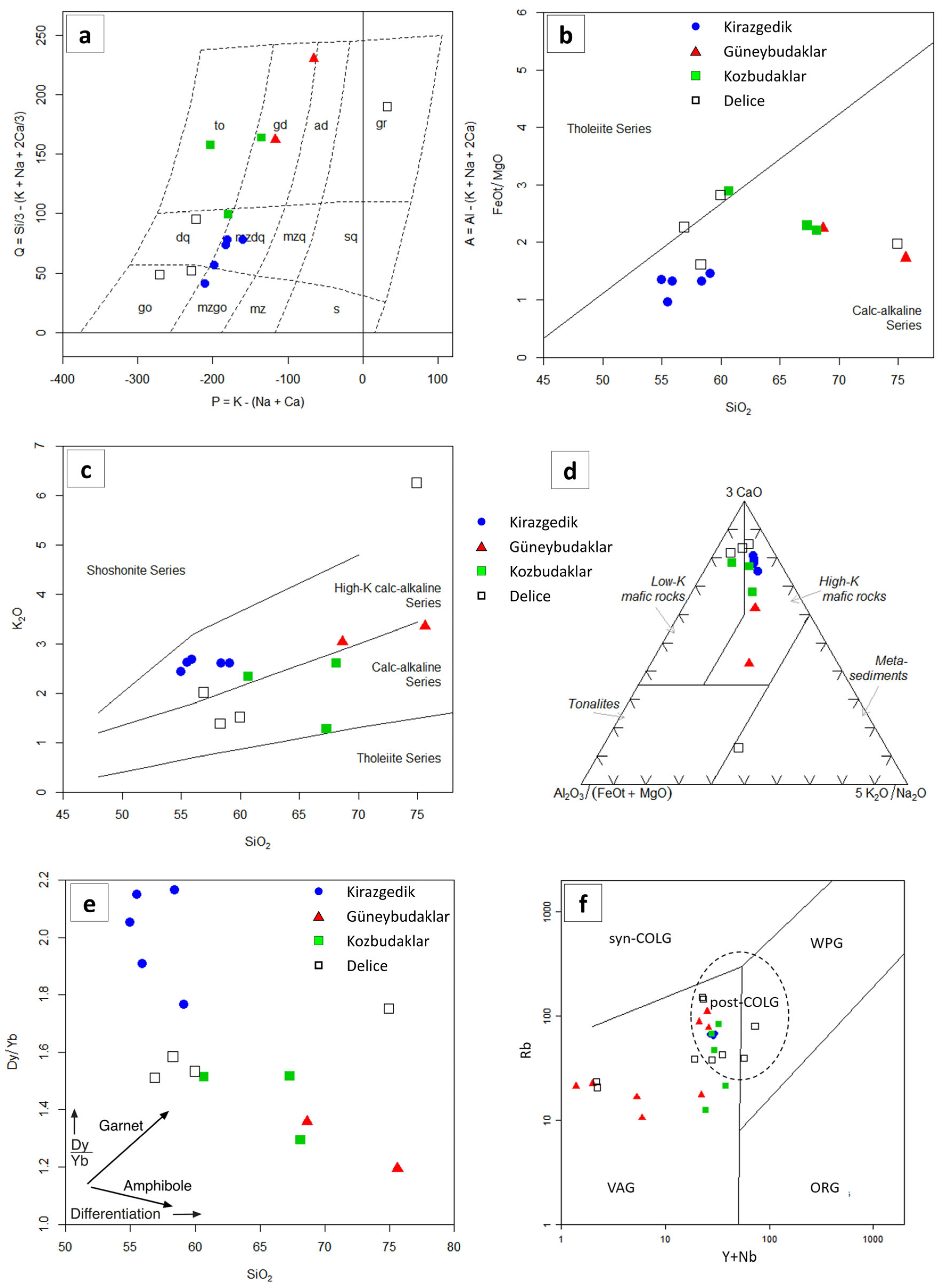
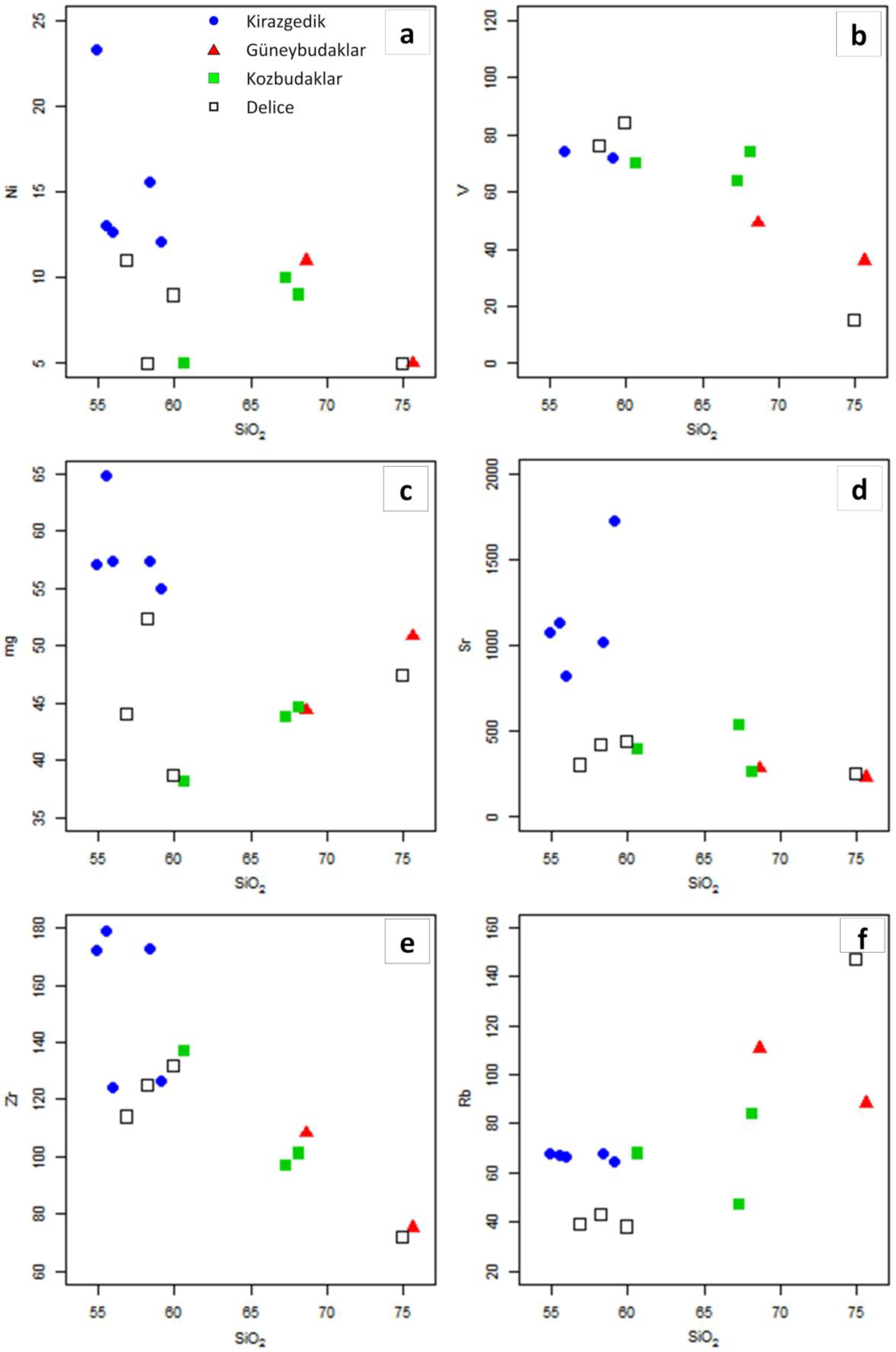
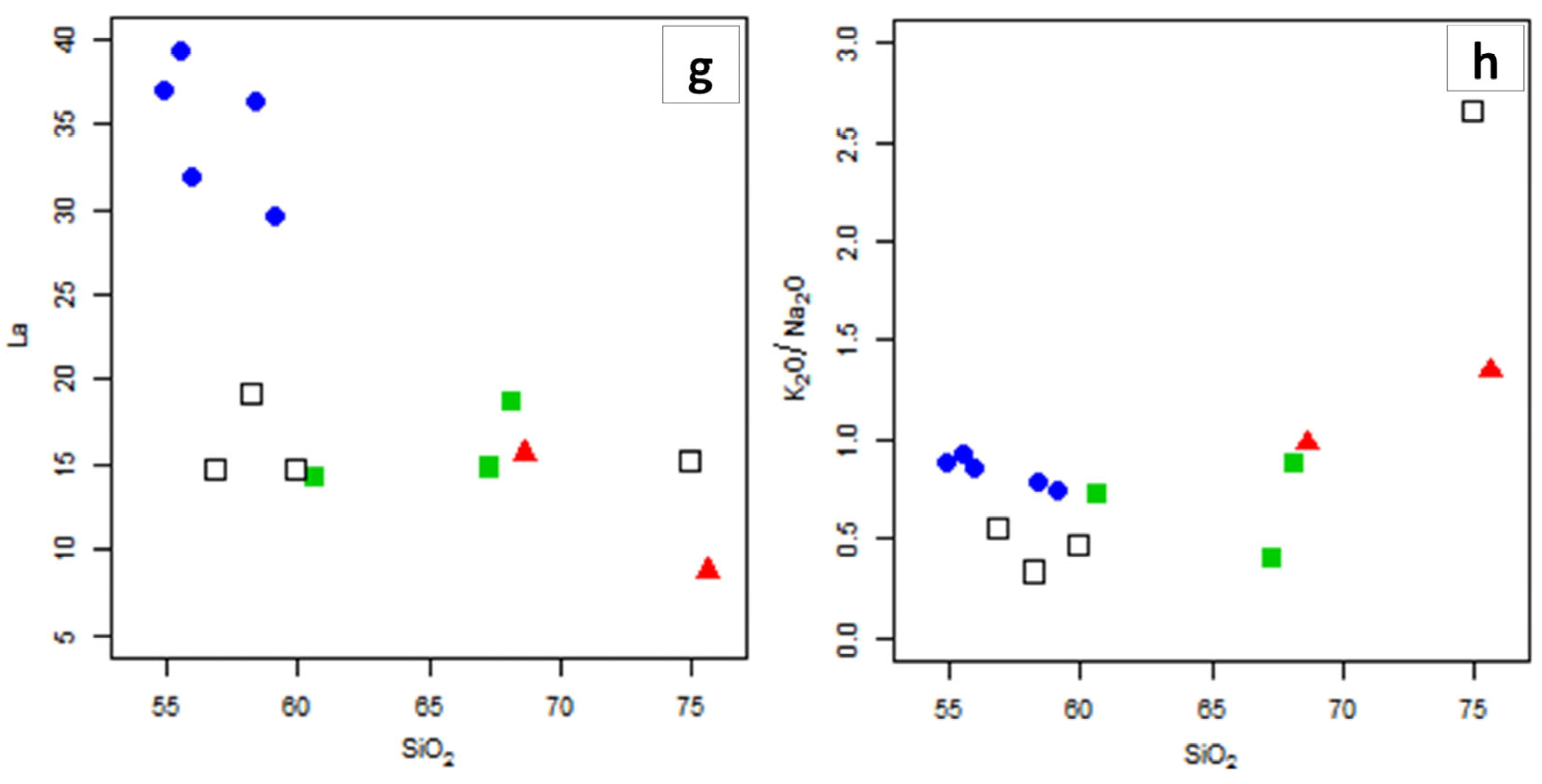
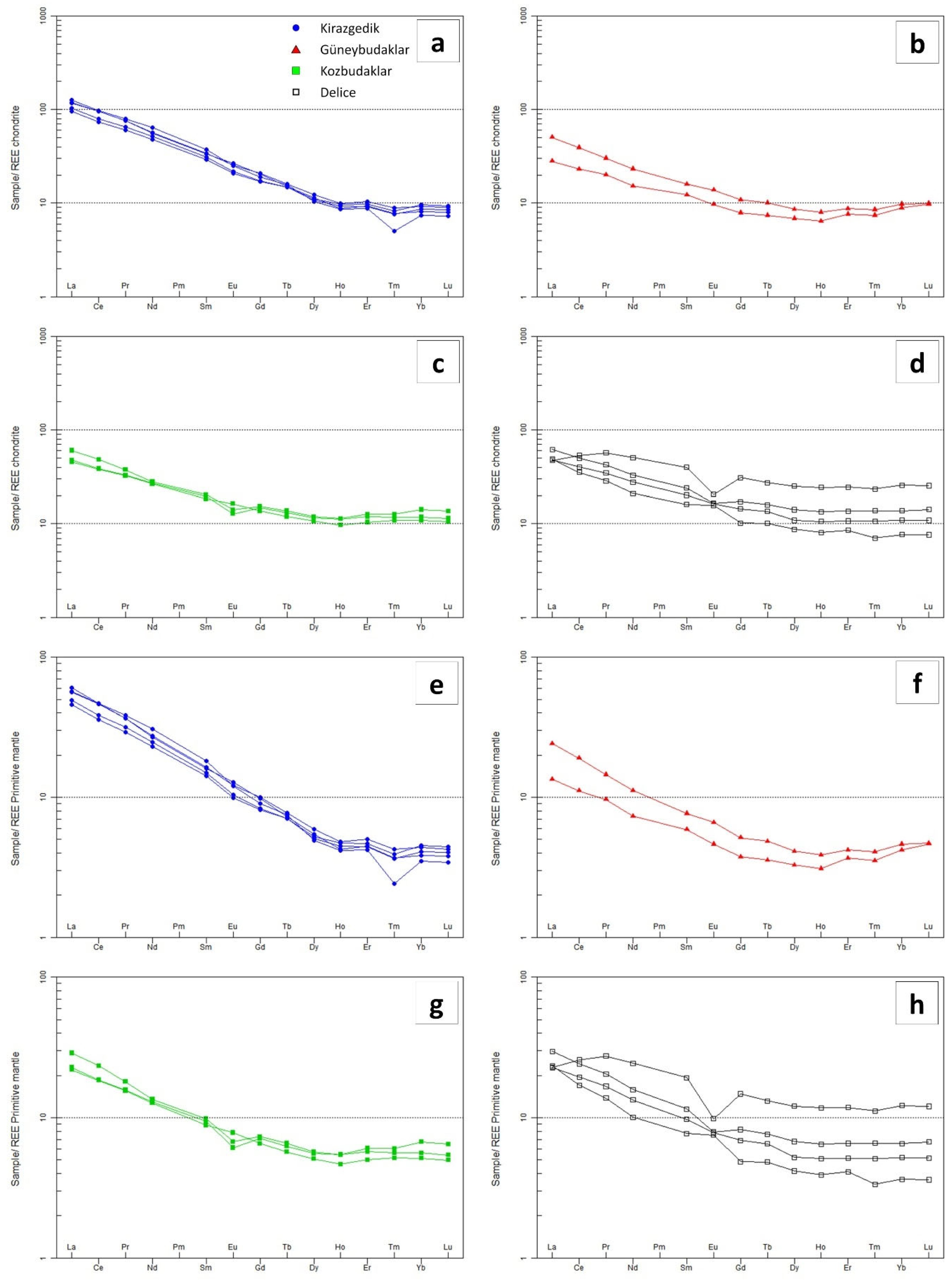
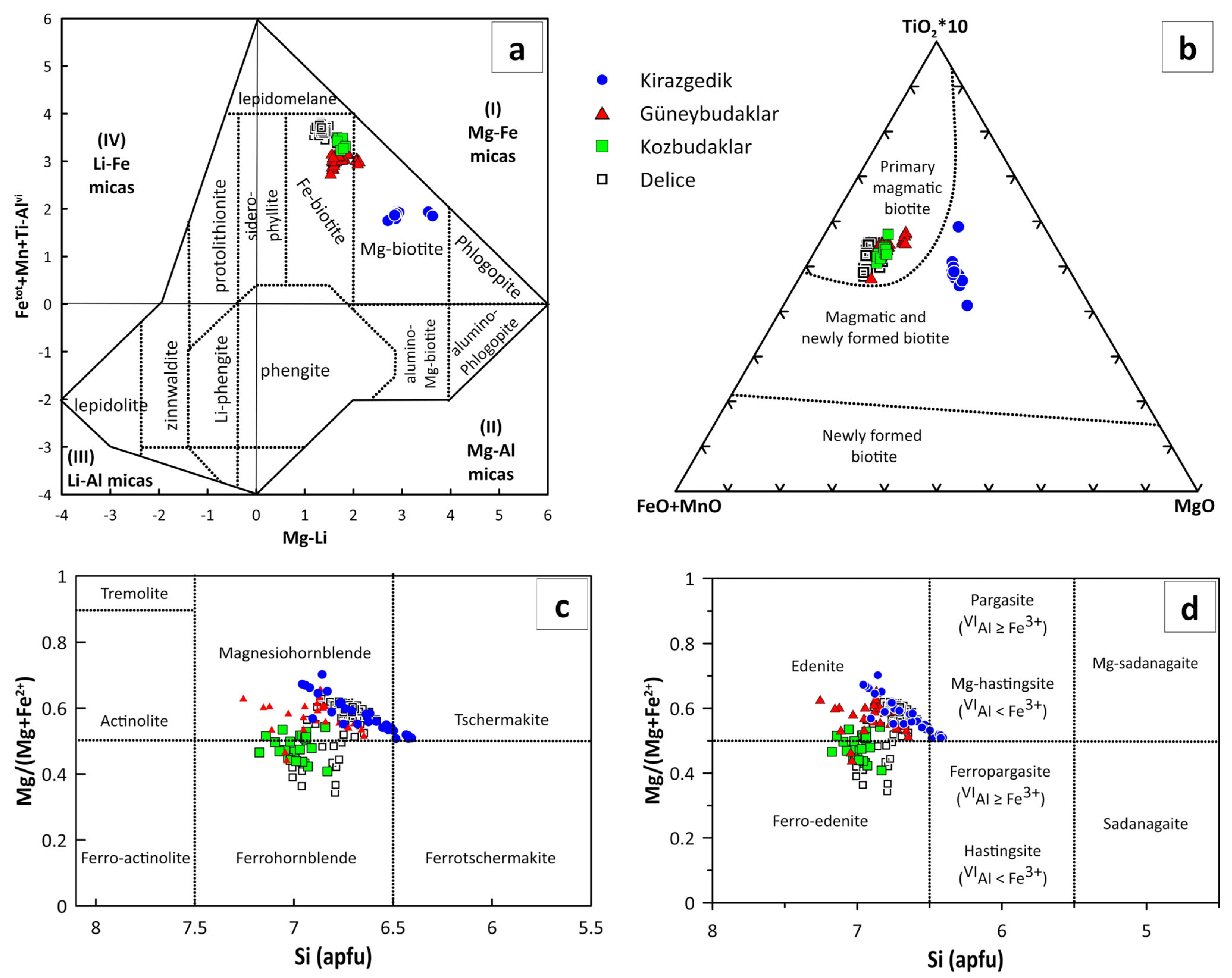
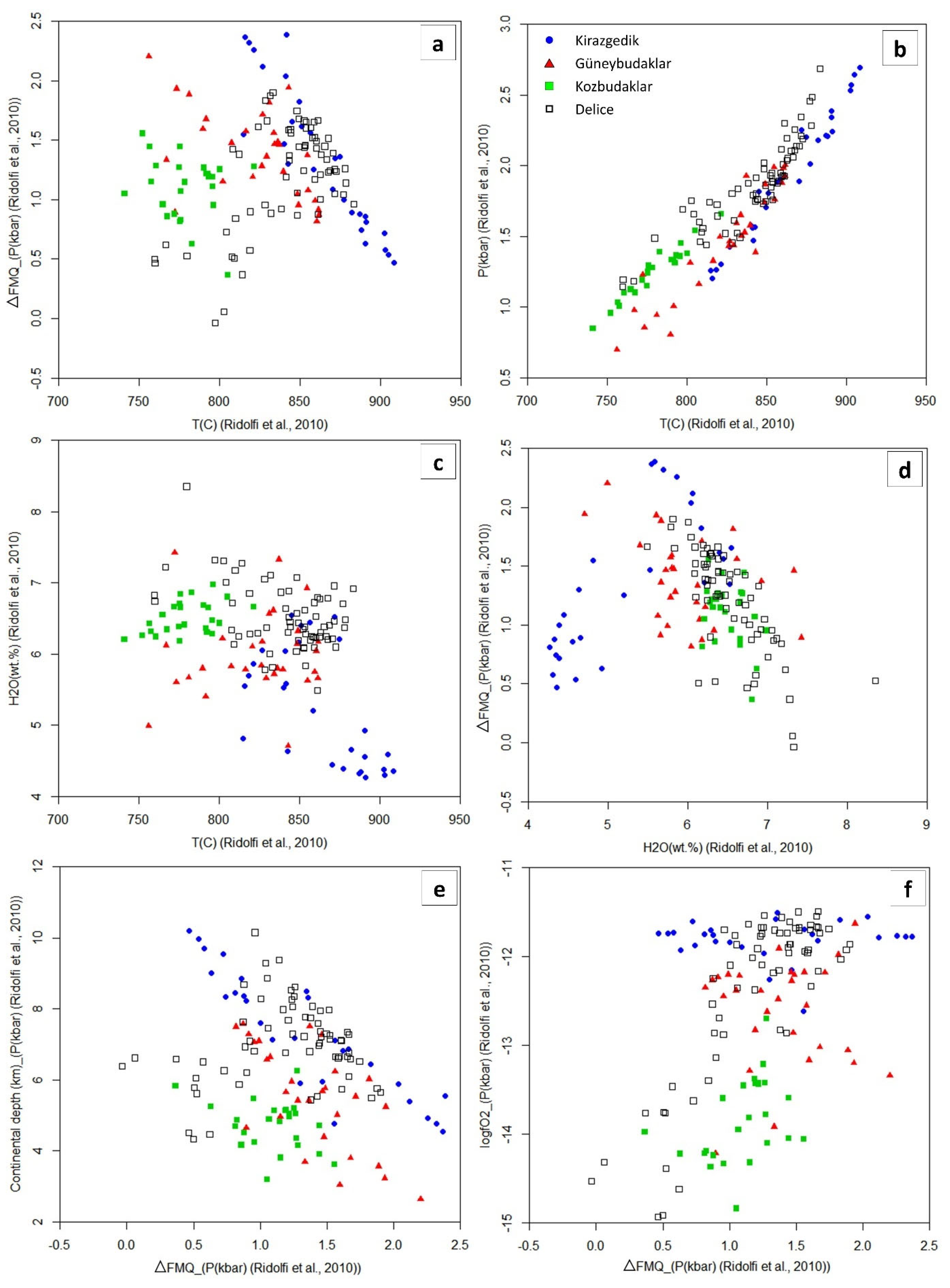
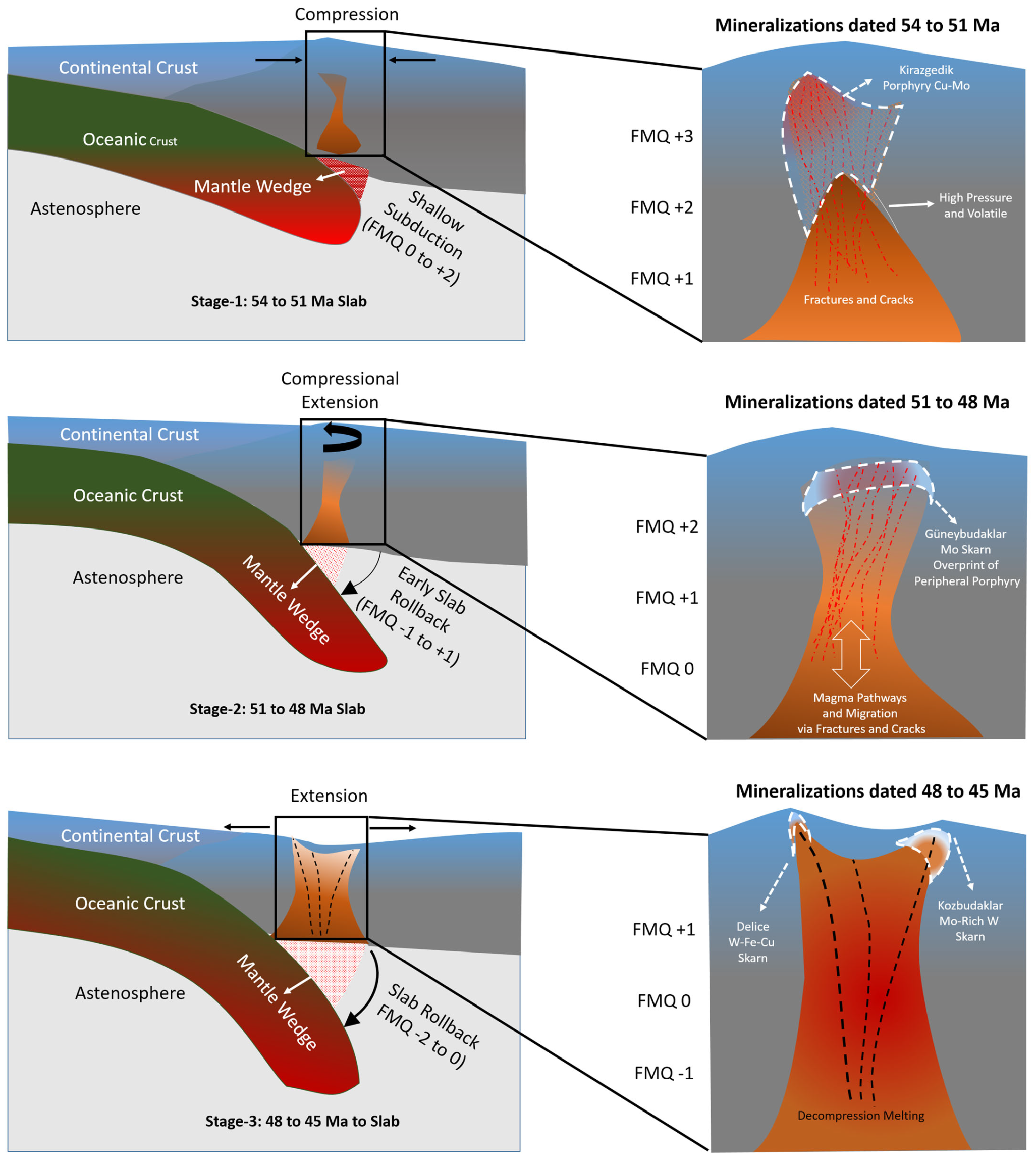
| Pluton | Sub-Unit | Rock Type | Textures | Main Minerals | References |
|---|---|---|---|---|---|
| Topuk | Main Body | Grd, Qz-Di, Qz-Mzd, Qz-Mzn | Porphyritic, hypidiomorphic | Grd: Pl, Qz, Kfs, Hb, Bt; Qz-Mzd: Pl, Qz, Kfs, Hb, Bt; Qz-Mzn: Pl, Qz, Kfs, Bt, Hb | Altunkaynak, et al. [29]; Kocatürk, et al. [14] |
| Delice | Ton, Grd, Afs-Gr | Granular, porphyritic | Ton: Pl ↑, Qz ↑, Hb, Bt, Kfs ↓; Grd: Pl, Qz, Kfs, Hb, Bt; Afs-Gr: Kfs ↑, Qz, Pl ↓, Bt, Ms | Kocatürk, et al. [14] | |
| Tepeldağ | South Tepeldağ | Qz-Mzd to Qz-Mzn | Hypidiomorphic granular | Qz-Mzd: Pl, Qz, Kfs, Hb, Bt; Mzgr: Pl, Qz, Kfs ↑, Bt, Hbl | Kocatürk, et al. [14] |
| North Tepeldağ | Qz-Di to Grd | Porphyritic | Qz-Di: Pl, Qz ↓, Hb, Bt, Kfs ↓; Grd: Pl, Qz, Kfs, Hb, Bt | Altunkaynak, et al. [29] | |
| Gürgenyayla | Main Body | Grd to Mzgr | Hypidiomorphic granular | Grd: Pl, Qz, Kfs, Hb, Bt; Mzgr: Pl, Qz, Kfs ↑, Bt, Hb | Altunkaynak, et al. [29] |
| Re (ppm) | ± 2α | 187Re (ppb) | ±2α | 187Os (ppb) | ±2α | Model Age (Ma) | ±2α with Decay Const (Ma) |
|---|---|---|---|---|---|---|---|
| 34.65 | 0.10 | 21,780 | 61 | 18.125 | 0.011 | 49.93 | 0.21 |
| DataSet | Kirazgedik | Güneybudaklar | Kozbudaklar | Delice | ||||||||
|---|---|---|---|---|---|---|---|---|---|---|---|---|
| (n = 11) | (n = 70) | (n = 15) | (n = 34) | |||||||||
| Min. | Max. | Av. | Min. | Max. | Av. | Min. | Max. | Av. | Min. | Max. | Av. | |
| SiO2 | 35.6 | 40 | 37.9 | 33.7 | 36.2 | 35 | 35 | 35.6 | 35.3 | 34.8 | 36.2 | 35.4 |
| TiO2 | 2.3 | 4.2 | 2.9 | 2.8 | 4.3 | 3.7 | 3.4 | 4.3 | 3.7 | 3.1 | 4.1 | 3.8 |
| Al2O3 | 13.4 | 14.8 | 14.2 | 13.8 | 16.8 | 15.6 | 14 | 14.4 | 14.2 | 13.8 | 15.1 | 14.3 |
| FeO | 11.6 | 12.9 | 12.5 | 19.2 | 23 | 22 | 22 | 23.8 | 22.9 | 22.8 | 25.6 | 24.7 |
| MnO | 0.2 | 0.3 | 0.2 | 0.2 | 0.7 | 0.3 | 0.4 | 0.4 | 0.4 | 0.5 | 0.6 | 0.6 |
| MgO | 16.5 | 19.7 | 17.3 | 7.6 | 11.5 | 8.8 | 8.6 | 9.6 | 9.1 | 6.9 | 9.4 | 7.8 |
| CaO | 0 | 3.4 | 0.4 | 0 | 0.1 | 0 | 0 | 0.1 | 0 | 0 | 0 | 0 |
| Na2O | 0.1 | 0.3 | 0.2 | 0 | 0.3 | 0.1 | 0.1 | 0.2 | 0.1 | 0 | 0.2 | 0.1 |
| K2O | 5.6 | 10.4 | 9.5 | 9.4 | 10.4 | 9.9 | 9 | 10.2 | 9.9 | 9.6 | 10.2 | 10 |
| Cr2O3 | 0 | 0.1 | 0 | 0 | 0.1 | 0 | 0 | 0.1 | 0 | 0 | 0.1 | 0 |
| H2O * | 3.3 | 3.5 | 3.4 | 3.5 | 3.8 | 3.6 | 3.6 | 3.7 | 3.6 | 3.6 | 3.7 | 3.7 |
| Li2O * | 0.7 | 1.9 | 1.3 | 0.1 | 0.8 | 0.5 | 0.5 | 0.7 | 0.6 | 0.4 | 0.9 | 0.6 |
| F | 1.3 | 1.5 | 1.4 | 0.3 | 0.7 | 0.6 | 0.4 | 0.5 | 0.5 | 0.3 | 0.4 | 0.4 |
| Cl | 0.1 | 0.2 | 0.2 | 0.1 | 0.2 | 0.1 | 0.1 | 0.2 | 0.1 | 0.1 | 0.2 | 0.1 |
| Atoms per formula unit (apfu) | ||||||||||||
| Si | 5.3 | 5.7 | 5.5 | 5.3 | 5.5 | 5.4 | 5.5 | 5.5 | 5.5 | 5.4 | 5.5 | 5.5 |
| Aliv | 2.2 | 2.5 | 2.4 | 2.5 | 2.7 | 2.6 | 2.5 | 2.5 | 2.5 | 2.5 | 2.6 | 2.5 |
| Alvi | 0 | 0 | 0 | 0 | 0.5 | 0.2 | 0 | 0.1 | 0.1 | 0 | 0.2 | 0.1 |
| Ti | 0.3 | 0.5 | 0.3 | 0.3 | 0.5 | 0.4 | 0.4 | 0.5 | 0.4 | 0.4 | 0.5 | 0.4 |
| Cr | 0 | 0 | 0 | 0 | 0 | 0 | 0 | 0 | 0 | 0 | 0 | 0 |
| Fe | 1.4 | 1.6 | 1.5 | 2.4 | 3 | 2.8 | 2.9 | 3.1 | 3 | 2.9 | 3.4 | 3.2 |
| Mn | 0 | 0 | 0 | 0 | 0.1 | 0 | 0 | 0.1 | 0.1 | 0.1 | 0.1 | 0.1 |
| Mg | 3.6 | 4.3 | 3.8 | 1.8 | 2.6 | 2 | 2 | 2.2 | 2.1 | 1.6 | 2.2 | 1.8 |
| Ca | 0 | 0.5 | 0.1 | 0 | 0 | 0 | 0 | 0 | 0 | 0 | 0 | 0 |
| Na | 0 | 0.1 | 0.1 | 0 | 0.1 | 0 | 0 | 0.1 | 0 | 0 | 0.1 | 0 |
| K | 1.1 | 1.9 | 1.8 | 1.9 | 2.1 | 2 | 1.8 | 2 | 2 | 1.9 | 2 | 2 |
| F | 0.6 | 0.7 | 0.6 | 0.2 | 0.4 | 0.3 | 0.2 | 0.2 | 0.2 | 0.1 | 0.2 | 0.2 |
| Cl | 0 | 0 | 0 | 0 | 0 | 0 | 0 | 0.1 | 0 | 0 | 0.1 | 0 |
| OH * | 3.3 | 3.4 | 3.3 | 3.6 | 3.8 | 3.7 | 3.7 | 3.8 | 3.7 | 3.7 | 3.8 | 3.8 |
| Li * | 0.4 | 1.1 | 0.8 | 0.1 | 0.5 | 0.3 | 0.3 | 0.4 | 0.4 | 0.3 | 0.5 | 0.4 |
| TOTAL | 19.7 | 20.4 | 20.2 | 19.8 | 20.1 | 19.9 | 19.8 | 20 | 20 | 19.9 | 20.1 | 20 |
| Parameters | ||||||||||||
| Altotal | 2.2 | 2.5 | 2.4 | 2.5 | 3.1 | 2.8 | 2.5 | 2.6 | 2.6 | 2.5 | 2.7 | 2.6 |
| Mg-Li | 2.7 | 3.6 | 3 | 1.5 | 2.1 | 1.7 | 1.7 | 1.8 | 1.7 | 1.2 | 1.7 | 1.4 |
| Fe + Mn + Ti-Alvi | 1.8 | 1.9 | 1.9 | 2.7 | 3.2 | 3.1 | 3.2 | 3.5 | 3.4 | 3.4 | 3.8 | 3.6 |
| X(Mg) = Mg/(Mg + Fe) | 0.7 | 0.7 | 0.7 | 0.4 | 0.5 | 0.4 | 0.4 | 0.4 | 0.4 | 0.3 | 0.4 | 0.4 |
| X(Fe) = Fe/(Fe + Mg) | 0.3 | 0.3 | 0.3 | 0.5 | 0.6 | 0.6 | 0.6 | 0.6 | 0.6 | 0.6 | 0.7 | 0.6 |
| Fe + Mn | 1.5 | 1.6 | 1.6 | 2.5 | 3 | 2.9 | 2.9 | 3.1 | 3 | 3 | 3.4 | 3.3 |
| Aliv + Fe + Ti | 1.7 | 1.9 | 1.8 | 2.9 | 3.8 | 3.5 | 3.4 | 3.6 | 3.5 | 3.4 | 3.9 | 3.7 |
| Fe + Mn + Ti | 1.8 | 1.9 | 1.9 | 3 | 3.5 | 3.3 | 3.3 | 3.6 | 3.5 | 3.4 | 3.9 | 3.7 |
| FeO/(FeO + MgO) | 0.4 | 0.4 | 0.4 | 0.6 | 0.7 | 0.7 | 0.7 | 0.7 | 0.7 | 0.7 | 0.8 | 0.8 |
| TiO2 × 10 | 23.1 | 42.3 | 28.8 | 27.7 | 42.7 | 37.1 | 33.9 | 42.7 | 36.7 | 30.8 | 41 | 37.5 |
| FeO + MnO | 11.8 | 13.1 | 12.8 | 19.9 | 23.2 | 22.3 | 22.4 | 24.2 | 23.3 | 23.3 | 26.2 | 25.3 |
| ln(Ti) | −1.4 | −0.8 | −1.2 | −1.1 | −0.7 | −0.8 | −0.9 | −0.7 | −0.9 | −1 | −0.7 | −0.8 |
| T (oC) | 497.6 | 523.2 | 507.9 | 269.3 | 369 | 296.9 | 280.4 | 311 | 295.7 | 231.1 | 303.4 | 257.1 |
| Kirazgedik | Güneybudaklar | Kozbudaklar | Delice | |||||||||
|---|---|---|---|---|---|---|---|---|---|---|---|---|
| (n = 28) | (n = 29) | (n = 25) | (n = 66) | |||||||||
| Dataset | Min. | Max. | Av. | Min. | Max. | Av. | Min. | Max. | Av. | Min. | Max. | Av. |
| SiO2 | 42.1 | 47.5 | 44.6 | 43.8 | 49.2 | 46.0 | 44.5 | 47.7 | 46.3 | 43.5 | 46.4 | 45.1 |
| TiO2 | 0.8 | 1.9 | 1.3 | 0.4 | 1.5 | 1.0 | 0.5 | 1.0 | 0.8 | 0.7 | 1.3 | 1.1 |
| Al2O3 | 7.5 | 10.4 | 9.1 | 5.2 | 9.5 | 8.0 | 5.9 | 8.7 | 7.4 | 6.9 | 10.5 | 9.0 |
| FeO | 11.7 | 18.0 | 15.7 | 13.1 | 22.6 | 16.1 | 17.1 | 21.3 | 19.3 | 14.1 | 23.3 | 16.5 |
| MnO | 0.4 | 0.9 | 0.6 | 0.4 | 1.2 | 1.0 | 0.8 | 1.0 | 0.9 | 0.8 | 1.3 | 0.9 |
| MgO | 10.4 | 15.5 | 12.2 | 9.6 | 14.0 | 11.9 | 8.3 | 11.4 | 10.1 | 6.8 | 13.5 | 11.5 |
| CaO | 11.2 | 12.1 | 11.7 | 10.1 | 12.6 | 11.7 | 10.8 | 11.9 | 11.3 | 10.5 | 11.6 | 11.2 |
| Na2O | 1.1 | 1.7 | 1.4 | 0.5 | 1.8 | 1.3 | 0.8 | 1.3 | 1.1 | 0.8 | 2.0 | 1.7 |
| K2O | 0.4 | 1.6 | 1.0 | 0.4 | 1.0 | 0.7 | 0.4 | 0.9 | 0.6 | 0.4 | 0.8 | 0.6 |
| Atomic fraction | ||||||||||||
| Si | 6.4 | 7.0 | 6.7 | 6.7 | 7.3 | 6.9 | 6.8 | 7.2 | 7.0 | 6.6 | 7.0 | 6.8 |
| Ti | 0.1 | 0.2 | 0.2 | 0.0 | 0.2 | 0.1 | 0.1 | 0.1 | 0.1 | 0.1 | 0.1 | 0.1 |
| Al | 1.3 | 1.9 | 1.6 | 0.9 | 1.7 | 1.4 | 1.0 | 1.5 | 1.3 | 1.3 | 1.9 | 1.6 |
| Fe2+ | 1.4 | 2.3 | 2.0 | 1.6 | 3.0 | 2.0 | 2.1 | 2.7 | 2.4 | 1.8 | 3.0 | 2.1 |
| Mn | 0.1 | 0.1 | 0.1 | 0.1 | 0.2 | 0.1 | 0.1 | 0.1 | 0.1 | 0.1 | 0.2 | 0.1 |
| Mg | 2.4 | 3.4 | 2.7 | 2.1 | 3.1 | 2.7 | 1.9 | 2.5 | 2.3 | 1.6 | 3.0 | 2.6 |
| Ca | 1.8 | 2.0 | 1.9 | 1.7 | 2.0 | 1.9 | 1.8 | 2.0 | 1.8 | 1.7 | 1.9 | 1.8 |
| Na | 0.3 | 0.5 | 0.4 | 0.2 | 0.5 | 0.4 | 0.2 | 0.4 | 0.3 | 0.2 | 0.6 | 0.5 |
| K | 0.1 | 0.3 | 0.2 | 0.1 | 0.2 | 0.1 | 0.1 | 0.2 | 0.1 | 0.1 | 0.2 | 0.1 |
| H | 2.0 | 2.0 | 2.0 | 2.0 | 2.0 | 2.0 | 2.0 | 2.0 | 2.0 | 2.0 | 2.0 | 2.0 |
| Mg/(Mg + Fe2+) | 0.5 | 0.7 | 0.6 | 0.4 | 0.7 | 0.6 | 0.4 | 0.5 | 0.5 | 0.3 | 0.6 | 0.6 |
| Fe/(Fe + Mg) | 0.3 | 0.5 | 0.4 | 0.3 | 0.6 | 0.4 | 0.5 | 0.6 | 0.5 | 0.4 | 0.7 | 0.5 |
| Al IV | 1.0 | 1.6 | 1.3 | 0.7 | 1.4 | 1.1 | 0.8 | 1.2 | 1.0 | 1.0 | 1.4 | 1.2 |
| Na + K + Ca | 2.2 | 2.7 | 2.5 | 2.0 | 2.6 | 2.4 | 2.2 | 2.4 | 2.3 | 2.2 | 2.5 | 2.4 |
| Pluton | Zone Description | Rock Type | Method | Age (Ma) | Reference |
|---|---|---|---|---|---|
| South-Tepeldağ | Porphyry Cu-Mo | Monzodiorite | LA-ICP-MS U-Pb | 54.56 ± 0.21 | Kocatürk, et al. [14] |
| Gürgenyayla | Porphyry Cu-Mo | Granodiorite | SHRIMP U-Pb | 51.02 ± 0.52 | Altunkaynak, et al. [29] |
| Gürgenyayla | Porphyry Cu-Mo | Granodiorite | CA-TIMS U-Pb | 51.5 ± 0.1 | Rabayrol, et al. [12] |
| Topuk | Güneybudaklar Mineralization | Molybdenite | Re-Os | 49.93 ± 0.21 | This Study |
| Topuk | Main Body | Granodiorite | SHRIMP U-Pb | 48.71 ± 0.44 | Altunkaynak, et al. [29] |
| Topuk | Delice | Tonalite | LA-ICP-MS U-Pb | 47.35 ± 0.21 | Kocatürk, et al. [14] |
| Topuk | Delice | AF-Granite | LA-ICP-MS U-Pb | 45.90 ± 0.29 | Kocatürk, et al. [14] |
Disclaimer/Publisher’s Note: The statements, opinions and data contained in all publications are solely those of the individual author(s) and contributor(s) and not of MDPI and/or the editor(s). MDPI and/or the editor(s) disclaim responsibility for any injury to people or property resulting from any ideas, methods, instructions or products referred to in the content. |
© 2025 by the authors. Licensee MDPI, Basel, Switzerland. This article is an open access article distributed under the terms and conditions of the Creative Commons Attribution (CC BY) license (https://creativecommons.org/licenses/by/4.0/).
Share and Cite
Kocatürk, H.; Kumral, M.; Sendir, H.; Kaya, M.; Creaser, R.A.; Abdelnasser, A. Magmatic Redox Evolution and Porphyry–Skarn Transition in Multiphase Cu-Mo-W-Au Systems of the Eocene Tavşanlı Belt, NW Türkiye. Minerals 2025, 15, 792. https://doi.org/10.3390/min15080792
Kocatürk H, Kumral M, Sendir H, Kaya M, Creaser RA, Abdelnasser A. Magmatic Redox Evolution and Porphyry–Skarn Transition in Multiphase Cu-Mo-W-Au Systems of the Eocene Tavşanlı Belt, NW Türkiye. Minerals. 2025; 15(8):792. https://doi.org/10.3390/min15080792
Chicago/Turabian StyleKocatürk, Hüseyin, Mustafa Kumral, Hüseyin Sendir, Mustafa Kaya, Robert A. Creaser, and Amr Abdelnasser. 2025. "Magmatic Redox Evolution and Porphyry–Skarn Transition in Multiphase Cu-Mo-W-Au Systems of the Eocene Tavşanlı Belt, NW Türkiye" Minerals 15, no. 8: 792. https://doi.org/10.3390/min15080792
APA StyleKocatürk, H., Kumral, M., Sendir, H., Kaya, M., Creaser, R. A., & Abdelnasser, A. (2025). Magmatic Redox Evolution and Porphyry–Skarn Transition in Multiphase Cu-Mo-W-Au Systems of the Eocene Tavşanlı Belt, NW Türkiye. Minerals, 15(8), 792. https://doi.org/10.3390/min15080792










